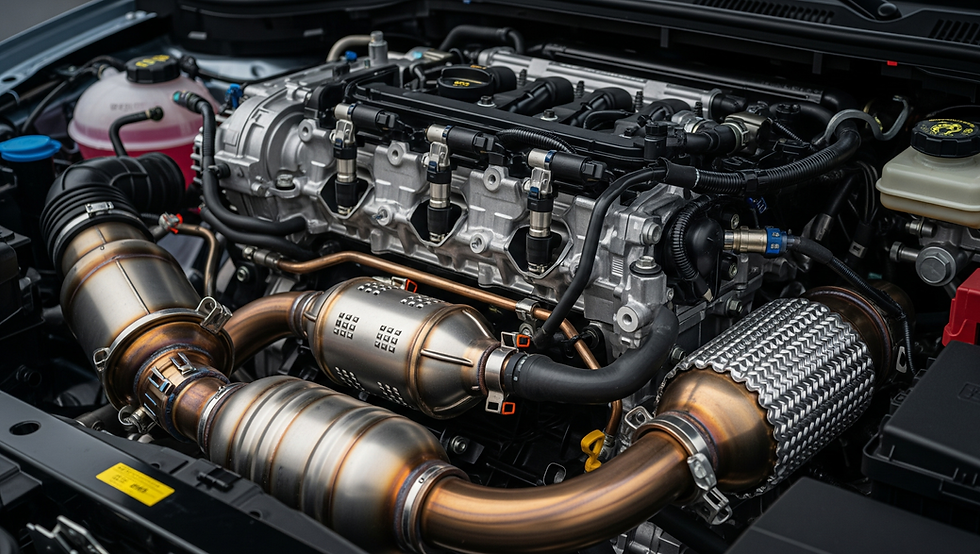Why Boats Need an Auxiliary Engine: Purpose and Benefits
- Raktim Das
- May 22
- 3 min read
Navigating throughout the ocean, large boats and other marine vessels typically have two types of engines: a main engine and an auxiliary engine. Though the main engine is essential to keep the boat moving, the secondary engine also holds equal importance.
In this article, we will explore the why the secondary engines is used and how it is beneficial for the boat:
Purpose of Auxiliary Engines:
The secondary engine in a boat holds a crucial role, especially for electrical and mechanical functions. The main propulsion engine helps with navigating the vessel against the waves. The secondary engine provides supplies power to maintain stability in both day-to-day operation and emergency conditions. Here’s how:
Electrical Power Distribution Across Systems: Electricity is more important when you’re in the midst of the ocean. Just consider living in the dark, surrounded by nothing but water. The auxiliary engine supplies electricity and energy to everything from bridge lighting to lower-deck machinery. Plus it helps mariners to keep in touch with the world. Without the engine, even minor power changes can lead to radar and GPS failure and poor communication.
Operating Hydraulic and Mechanical Systems: In the commercial marine industry, fishing trawlers and freight ships are very much needed. These engines are essential to use cranes, cargo winches, anchor systems, and net-hauling gear. If the engine doesn’t work, then the entire process will be on hold, and you may end up with costly delays at port or worse at sea.
Controlling Temperature through the Vessel: Temperature in the ocean can suddenly fall or rise. To keep your crew comfortable, you need ventilation, air conditioning, refrigeration, and a water pressure system, which are all powered by an auxiliary engine.
Backup and Emergency Assistance: Emergency scenarios always come uninvited in the ocean. Thus, mariners should always equip themselves with a functioning secondary engine for emergency lighting, distress signals, fire pumps, and communication.

Key Benefits of Using a Marine Auxiliary Engine
A well-built marine auxiliary engine improves energy efficiency, reduces emissions, and extends the life of the vessel’s main propulsion systems. It allows fishing boats to separate critical support tasks from the heavy-duty propulsion engine, improving both safety and performance during voyages long or short.
Following are a few benefits of choosing the right auxiliary engine for your boat:
Increases fuel efficiency
When navigating through the ocean, fuel efficiency is a major factor. The secondary engines reduce strain on the main propulsion engine by handling different tasks like power supply. It helps the main engine to run at maximum load without consuming too much fuel and helps to avoid unnecessary wear and tear.
Lowers Environmental Impact
With the increasing global warming issues, it is essential to consider adopting sustainable practices even for boats. Modern auxiliary engines are built with lower emissions profiles that comply with international marine pollution standards. By using a cleaner, smaller engine to power support systems, boats can lower their carbon footprint.
Reduces Downtime
Even during engine maintenance or unforeseen breakdowns, the secondary engine acts as a support system. For systems like cargo cranes, bow thrusters, and water jets, the auxiliary help makes sure these stay functional in transit or during docking. This means ships can keep schedules tight, avoid costly delays, and maintain safety protocols without compromise.
Offers Safety in Remote or Harsh Conditions
In harsh weather or isolated maritime zones, your engine plays a critical role. The auxiliary engine provides a much-needed backup for essential navigation and communication systems. If the main engine fails, the auxiliary system can sustain operations long enough for repairs, rerouting, or rescue, which is non-negotiable in high-sea emergencies or technical failures.
Final Thoughts
In the marine industry, safety always takes the top priority. And the auxiliary engine stand is the backbone, offering essential support to keep the vessel functioning safely. It allows the main engine to do what it does best while taking on the critical but often overlooked tasks that keep a vessel afloat and functional.



Comments